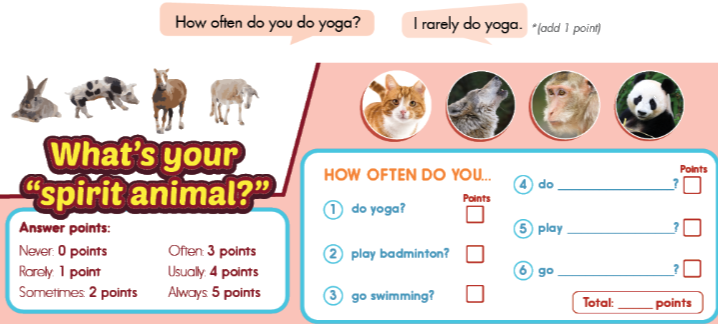Đừng bỏ lỡ những tính năng hấp dẫn của Baitap365.com
Unit 4: Festivals and free time
Lesson 1 - Unit 4 - Tiếng Anh 6 - iLearn Smart World
Lesson 2 - Unit 4 - Tiếng Anh 6 - iLearn Smart World Lesson 3 - Unit 4 - Tiếng Anh 6 - iLearn Smart World Review – Unit 4 – Tiếng Anh 6 – iLearn Smart World Writing – Unit 4 – Tiếng Anh 6 – iLearn Smart World Luyện tập từ vựng Unit 4 Tiếng Anh 6 iLearn Smart World Tiếng Anh 6 iLearn Smart World Unit 4 Từ vựngLesson 1 - Unit 4 - Tiếng Anh 6 - iLearn Smart World
a. Listen to Lisa and Max talking about free time activities. Does Max like reading? Yes/ No b. Now, listen and fill in the blanks. a. Listen to Lisa and Max talking about free time activities. Does Max like reading? Yes/ No b. Now, listen and fill in the blanks. a. Listen and repeat. b. Fill in the blanks with the adverbs of frequency. c. Look at the table and write the answers. Now, ask your partner how often they do these activities.
New Words - a
a. Fill in the blanks. Listen and repeat.
(Điền vào chỗ trống. Nghe và lặp lại.)
| often never sometimes always rarely usually |

New Words - b
Write an activity under each adverb. Take turns using them in a sentence.
(Viết một hoạt động bên dưới mỗi trạng từ. Luân phiên sử dụng chúng trong một câu.)
I never watch movies.
(Tôi không bao giờ xem phim.)
Listening - a
a. Listen to Lisa and Max talking about free time activities. Does Max like reading? Yes/ No
(Nghe Lisa và Max nói về các hoạt động trong thời gian rảnh. Họ có thích đọc sách không? Có / Không)

Listening - b
b. Now, listen and fill in the blanks.
(Giờ thì, nghe và điền vào chỗ trống.)
1. Lisa____________goes to the bookstore on Fridays.
2. Max____________plays video games when he gets home from school.
3. Max____________plays soccer on the weekends.
4. Lisa____________rides her bike on Saturdays.
Grammar - a
a. Listen and repeat.
(Nghe và lặp lại.)
Boy: How often do you play soccer?
(Bạn chơi bóng đá thường xuyên như thế nào?)
Girl: I usually play soccer on the weekends. (every Saturday)
(Tôi thường chơi bóng đá vào cuối tuần.) (mỗi thứ Bảy)
Grammar - b
b. Fill in the blanks with the adverbs of frequency.
(Điền vào chỗ trống với các trạng từ chỉ tần suất.)

Grammar - c
c. Look at the table and write the answers.
(Nhìn bảng và viết câu trả lời.)
1. How often does Jack go shopping?
(Jack thường đi mua sắm như thế nào?)
2. How often does Bobby do his homework?
(Bobby thường làm bài tập về nhà như thế nào?)
3. How often does Sarah play soccer?
(Sarah thường chơi bóng đá như thế nào?)
4. How often does Amanda have barbecues?
(Amanda thường tổ chức tiệc nướng như thế nào?)
|
Name |
Activity |
Frequency |
|
Jack |
go shopping |
rarely |
|
Bobby |
do homework |
always |
|
Sarah |
play soccer |
sometimes |
|
Amanda |
have barbecues |
often |
Grammar - d
d. Now, ask your partner how often they do these activities.
(Giờ thì, hỏi bạn của em họ làm những hoạt động này thường xuyên như thế nào.)
Pronunciation - a
Sentence Stress
(Trọng âm của câu)
a. Stress the adverbs for emphasis.
(Trọng âm của các trạng từ được nhấn mạnh.)
I sometimes play badminton on the weekends.
(Tôi thường chơi cầu lông vào cuối tuần.)
Pronunciation - b
b. Listen to the sentences and focus on the underlined words.
(Nghe các câu và tập trung vào các từ được gạch dưới.)
I sometimes play badminton on the weekends.
(Tôi thường chơi cầu lông vào cuối tuần.)
I always go swimming after school.
(Tôi luôn đi bơi sau giờ học.)
Pronunciation - c
c. Listen and cross out the one with the wrong sentence stress.
(Nghe và loại bỏ câu có trọng âm của câu sai.)
I often watch movies on weekends.
(Tôi thường xem phim vào cuối tuần.)
I usually play soccer on Sundays.
(Tôi thường xuyên chơi đá bóng vào các ngày Chủ nhật.)
Pronunciation - d
d. Read the sentences with the correct sentence stress to a partner.
(Cùng với một người bạn đọc câu có trọng âm của câu đúng.)
Practice
Ask and answer.
(Hỏi và trả lời.)
- How often do you go running?
(Bạn chạy bộ thường xuyên như thế nào?)
- I rarely go running.
(Tôi hiếm khi chạy bộ.)
|
after school on the weekends in the afternoon in the mornings on Saturdays |

Speaking - a
What’s Your “Spirit Animal?”
(“Linh vật” của bạn là gì?)
a. You’re doing a quiz about your free time activities to find out your “spirit animal”. Work in pairs. Add three more activities and then ask your friend to complete the quiz.
(Em đang làm một bảng câu đố về các hoạt động trong thời gian rảnh rỗi để tìm ra “linh vật” của em. Làm việc theo cặp. Thêm ba hoạt động nữa và sau đó hỏi bạn em để hoàn thành câu hỏi.)
- How often do you do yoga?
(Bạn tập yoga thường xuyên như thế nào?)
- I rarely do yoga.
(Tôi hiếm khi tập yoga.)

Speaking - b
b. Turn to page 125 File 13 to find out what your partner’s “spirit animal” is. Share with the class.
(Chuyển đến trang 125 File 13 để tìm ra “linh vật” của bạn em là gì. Chia sẻ với cả lớp.)
Từ vựng
1.
2.
3.
4.
5.
6.
Mẹo tìm đáp án nhanh
Search Google: "từ khóa + baitap365" Ví dụ: "Bài 5 trang 13 SGK Vật lí 12 baitap365